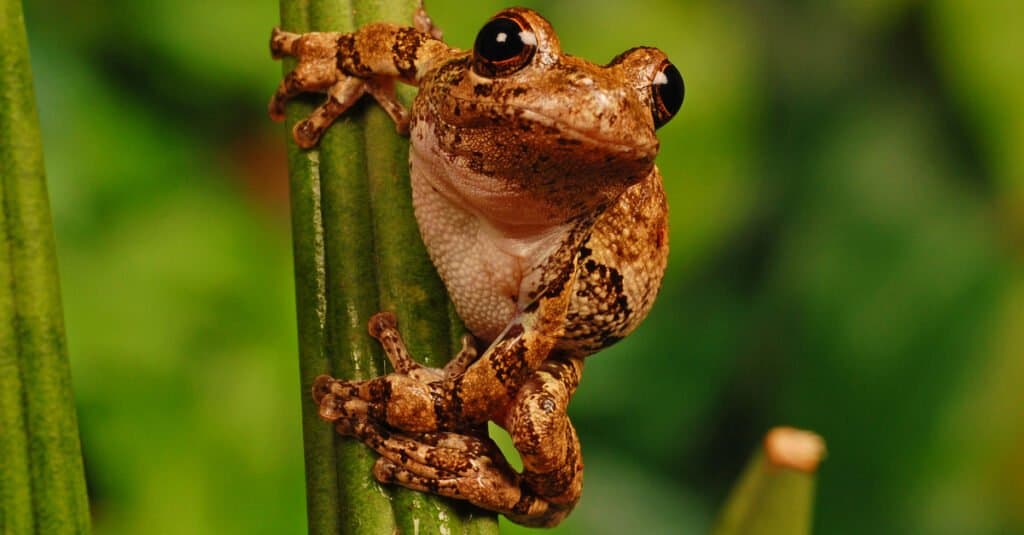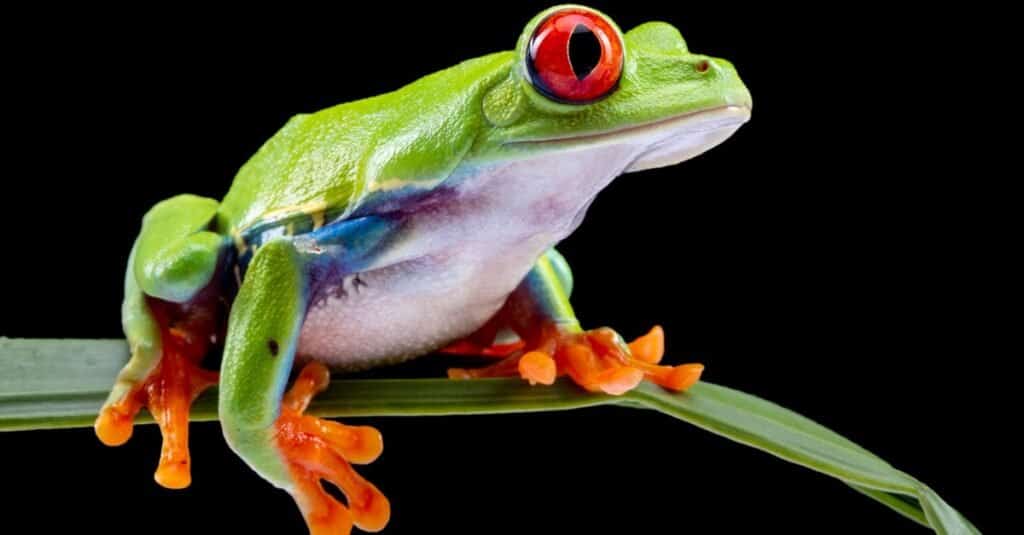Everyone’s afraid of something, but sometimes our fears are so strong they affect our lives in surprisingly significant ways. Though frogs might not seem very intimidating, the fear of frogs is actually more common than most people would initially believe.
But what could cause a fear of such a small and (mostly) harmless animal? Furthermore, why are some fears and phobias so unusual, and why would anyone be scared of frogs? Read on as I explore these questions in-depth below to provide a better understanding of fears, phobias, and the reasons why even the most unassuming animals can cause such visceral reactions in some people.
Fears Vs. Phobias: What’s the Difference?

Although frogs aren’t very menacing to most, they can be downright terrifying to people with a phobia of them.
©Milan Zygmunt/Shutterstock.com
Before we get into what we call a phobia of frogs and why it exists, it helps to understand what exactly fear is versus a full-blown phobia. Many people often use the terms interchangeably, but they’re actually two distinct emotional responses.
While fear is a normal, instinctive response to danger meant to keep us safe, a phobia is a bit more complex. Fear is a reasonable, instinctive reaction to a perceived threat, and it protects us from harm. A phobia, on the other hand, is generally an exaggerated response to something that doesn’t actually present a legitimate danger. It’s common for phobias to be referred to as “excessive” or “irrational fears.”
For example, experiencing fear in response to being injured or threatened is a pretty natural response to danger. Fear is also the reason you don’t walk into heavy traffic while in town or off a cliff while hiking. Fear protects you from legitimate harm. But where fear protects us, phobias unnecessarily shield us even from things that are mostly or completely harmless.
This is why we generally view an intense fear of frogs as a phobia. For the most part, frogs are pretty harmless to humans, provided we don’t go around licking poison dart frogs or sticking our fingers in bullfrogs’ mouths. This brings us to the main question at hand: what is the official name for a phobia of frogs?
What is a Phobia of Frogs Called?

Many Ranidaphobia sufferers find frogs’ eyes to be unnerving.
©iStock.com/William Krumpelman
A phobia of frogs is formally referred to as Ranidaphobia. By extension, an excessive fear of amphibians in general, including salamanders, newts, and toads, is called Batrachophobia. These phobias aren’t quite as common as, say, the phobia of heights (Acrophobia) or spiders (Arachnophobia). However, they can still affect the lives of those afflicted in many significant ways.
Some key symptoms of Ranidaphobia include:
- Severe anxiety or even panic attacks when near frogs or toads
- Shortness of breath
- Chest tightness
- Digestive issues, like nausea or a sour stomach
- Obsessive thoughts about encountering frogs or toads
- Avoiding certain places or situations for fear of encountering a frog or toad
- Increased heart rate
- Sweating
- Shaking
Many of these symptoms can occur when a Ranidaphobe even so much as thinks about frogs or toads. This can be debilitating, even if there aren’t many situations where one would encounter frogs on a daily basis. People with this phobia may avoid certain places where they think they may have a chance of encountering a frog, like local parks or hiking trails or even their backyard, even if that chance is extremely slim and would likely present no legitimate danger to them.
Why do some people experience such an extreme fear, then?
Why Are Some People Afraid of Frogs?

Many people with Ranidaphobia also find frogs’ legs and how far they can jump to be frightening.
©Deatonphotos/Shutterstock.com
There are many unique reasons why someone would develop a phobia of frogs. Usually, phobias originate either from superstitions, spiritual beliefs, or a bad experience the person had in the past, perhaps as a child. For animal-based phobias specifically, even a single negative experience with a certain animal can trigger a lifelong, debilitating fear.
With some animal-based phobias, historical beliefs and attitudes can influence them. Frogs in particular have been symbols of many different concepts throughout history. To some, they are signs of prosperity and luck. In other cultures, they’re bad omens or even symbols of disease. Spiritual beliefs and even superstitions have a strong influence on phobias in this way.
Alternatively, phobias can arise from a frightening or even traumatizing experience the sufferer had in the past or possibly as a child. Some Ranidaphobes cite instances where frogs jumped on them or bit them as children, which triggered and even reinforced their fear later in life. These formative experiences can be very influential in the development of fears and phobias, as they tend to stick with the sufferer for many years or even a lifetime.
How Do You Treat Phobias?

Exposing patients to pictures of frogs like this
red-eyed tree frog
is often the first step of exposure therapy for Ranidaphobia.
©Dave Denby Photography/Shutterstock.com
Today, there are many ways medical professionals treat phobias in a psychiatric context. The most common methods are one-on-one counseling to work through past experiences that triggered the phobia, cognitive behavioral therapy (CBT), and, most notably, exposure therapy.
Exposure therapy is perhaps the most common means of treatment for phobias. This involves a medical professional exposing a patient to certain elements or “small doses,” so to speak, of what triggers their phobia.
When it comes to Ranidaphobia, a therapist might start treatment by simply exposing their patient to pictures and videos of frogs. Eventually, the goal would be to work up to exposing the sufferer to looking at, interacting with, and perhaps even touching or holding actual frogs in person.
Over time, the influence of the phobia on the patient will lessen through repeated, controlled exposures. Many healthcare providers will combine this with talk therapy and cognitive behavioral therapy to identify and deconstruct problematic thoughts and behaviors related to the person’s phobia.
The photo featured at the top of this post is © Dave Denby Photography/Shutterstock.com
Thank you for reading! Have some feedback for us? Contact the AZ Animals editorial team.






